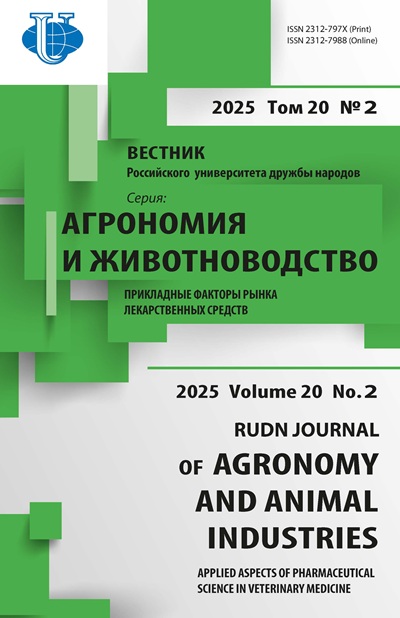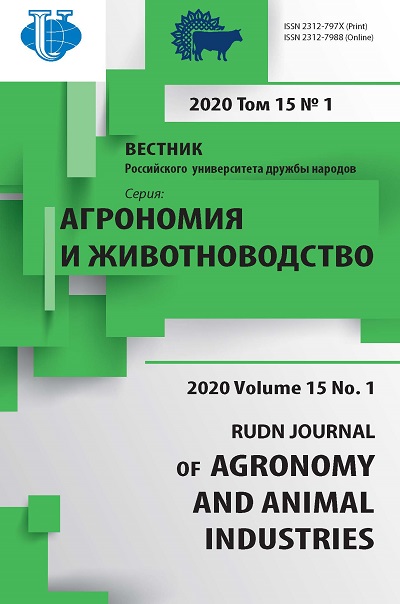Adaptation of foreign technologies of intensive cultivation of scots pine planting material in Kazakhstan
- Authors: Kabanova S.A.1, Bortsov V.A.1, Danchenko M.A.2
-
Affiliations:
- Kazakh Research Institute of Forestry and Agroforestry
- Tomsk State University
- Issue: Vol 15, No 1 (2020)
- Pages: 40-50
- Section: Crop production
- URL: https://agrojournal.rudn.ru/agronomy/article/view/19542
- DOI: https://doi.org/10.22363/2312-797X-2020-15-1-40-50
- ID: 19542
Cite item
Full Text
Abstract
The purpose of the research was the adaptation of foreign technologies for intensive and accelerated cultivation of Scots pine planting material in Kazakhstan. Objects of research were annual seedlings of scots pine in forest nurseries of Pavlodar, Akmola, and North Kazakhstan regions. The experiments were established in 4 directions: application of dry growth regulators to soil, pre-sowing seed treatment with growth regulators, soaking seeds in stimulants and fungicide, pre-sowing watering of the soil with growth regulators. It was established that seed quality decreased significantly compared to the last year, only seeds from Pavlodar region had high indicators. Seeds from the nursery ‘Ertic Ormany’ had the highest average indicators of soil germination (58.7…67.8%). In ‘Bukhpa’, the highest germination was observed in seeds soaked with Zircon + Trichocin (3 + 2 hours). Baikal growth regulator and AridGrow slightly increased germination in the nursery of Arykbalyk branch of ‘Kokshetau’. In the forest nursery ‘Ertis Ormany’, the highest annual seedlings were obtained in variants with presowing treatment of scots pine seeds with stimulants and watering the soil with growth substances. The average height of experimental seedlings was 4.32 and 4.64 cm, respectively. The combined use of Zircon and Trichocin increased seedling growth in ‘Bukpa’ nursery to 1.42 cm, which was the highest value. It was revealed that the technologies used in neighboring countries for intensive cultivation of scots pine seedlings showed a positive effect only when using Citovit. According to other experiments, it was determined that seedlings of scots pine grown from seeds with pre-sowing treatment in Gumat+7 for 12 hours had the best growth indicators in height. Increased soil fertility through applying nitrogen, phosphorus fertilizers, soil activator AridGrow and KZ Cultury significantly accelerated growth of scots pine seedlings.
About the authors
Svetlana Anatolyevna Kabanova
Kazakh Research Institute of Forestry and Agroforestry
Author for correspondence.
Email: Kabanova.05@mail.ru
Candidate of Biological Sciences, Head of the Department of Forest Reproduction and Afforestation
Schuchinsk, KazakhstanValery Anatolyevich Bortsov
Kazakh Research Institute of Forestry and Agroforestry
Email: bortsov_1969@mail.ru
Junior Researcher, Department of reforestation and afforestation
Schuchinsk, KazakhstanMatvey Anatolyevich Danchenko
Tomsk State University
Email: mtd2005@sibmail.com
Candidate of Geographical Sciences, Associate Professor, Department of forestry and landscape construction, Biological Institute
Tomsk, Russian FederationReferences
- Smirnov AI, Orlov FS, Drozdov II. Influence of low frequency electromagnetic field on seed germination and growth of seedlings of Scots pine and Norway spruce. Russian Forestry Journal. 2015; (3):53–58. (In Russ).
- Fadkin GN, Vinogradov DV, Shchur AV. Effect of iron nanocrystalline powder on the yield of scots pine planting material suitable for mechanized planting. The Bulletin of the Belarusian-Russian University. 2015; (2):136–142. (In Russ).
- Filonik IA, Aprasyuhin AI, Nikitin MM. Stimulyator prorastaniya, rosta i razvitiya drevesnyh rastenij i sposob stimulyacii prorastaniya, rosta i razvitiya drevesnyh rastenij [Stimulator of germination, growth and development of woody plants and a method for stimulating germination, growth and development of woody plants]. Patent RUS, no. 2362303, 2007. (In Russ).
- Gaponko EA, Kanickaya LV. Evaluation of the effect of stimulants on germination energy and germination of scots pine (Pinus sylvestris) seeds. Advances in current natural sciences. 2018; (8):46–51. (In Russ). doi: 10.17513/use.36835
- Prokopev AP. Ispolzovanie biologicheski aktivnyh veshchestv pri vyrashchivanii sosny obyknovennoj (Рinus sylvestris l.) v lesnyh pitomnikah Srednego Povolzhya. [Use of biologically active substances when growing scots pine (Pinus sylvestris l.) in forest nurseries of the Middle Volga region] [Dissertation] Orenburg; 2013. (In Russ).
- Ustinova TS, Zurov RN. Influence of Gumat+7 on growth processes of coniferous plant species. Actual problems of the forestry complex. 2010; 26:115–118. (In Russ).
- Kabanova SA, Danchenko AM, Danchenko MA. The effect of stimulants on seed germination and growth of seedlings of pinus sylvestris in Northern Kazakhstan. Advances in current natural sciences. 2016; (8):88–92. (In Russ).
- Kabanova SA, Danchenko MA, Borcov VA, Kochegarov IS. Results of pre-sowing treatment of seeds of scots pine with growth stimulants. Forestry Engineering Journal. 2017; 7(2):75–83. (In Russ). doi: 10.12737/ article_5967e97d74f307.86943920
- Aphalo PJ, Rikala R, Sanchez RA. Effect of CCC on the morphology and growth potential of containerised silver birch seedlings. New Forests. 1997; 14(3):167–177. doi: 10.1023/A:1006568813442
- Materechera SA. Influence of pre-sowing seed treatments on the germination of moringa (Moringa oleifera Lam.). Acta Horticulturae. 2017; 1158: 149–158. doi: 10.17660/ActaHortic.2017.1158.18
- Kovalevskij SB, Taranenko YN. Growing of Scots pine seedlings using plant growth regulators and composite fertilizers. Izvestia sankt-peterburgskoj lesotehniceskoj akademii. 2013; 204:47–55. (In Russ).
- Kulagin AA, Sahnov VV, Prokof’ev A. P. Effect of biologically active substances on the growth and viability of scots pine seedlings in the first year of growing. Izvestia Orenburg state agrarian university. 2012; (3):12–13. (In Russ).
- Prokazin NE, Lobanova EN, Pentelkina NV, Ivanyusheva GI, Sahnov VV, Petrov VA, et al. Production of softwood stock with growth promoter applications. Forestry information. 2013; (2):9–15. (In Russ).
- Sнershnev IV, Zvyagina GA. Technology for growing standard seedlings of scots pine in open ground in the conditions of the educational and experimental forestry of the Bryansk forest area. Actual problems of the forestry complex. 2006; 13:114–116 (In Russ).
Supplementary files















